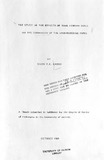| dc.description.abstract | Corrosion of metallic structures buried in the soil,
or in contact with soils, has been a serious engineering and
economic problem in most par ts of the world. A research
programme was conducted to investigate the corrosive
properties of the soils in which under ground pipes were laid.
Domestic water-supply pipes were laid both in the field and
in the labor e tor y .
Soil samples were collected from various sites in Nairobi
City. The soils were placed half-way in plastic containers
measur inq 153mm x 245mm x 225mm. Three preweighed metal
pipes, cut to size of 15311lm long, were laid horizontally in
each of the containers. Soil was added to cover the pipes and
an al r+t iqht lid was used to cover each container.
The pipes were unearthed at intervals of four months,
cleaned and examined for the ex tent and type of corrosion
that had taken place. After dyinq , each pipe was weighed
and the mass lost during burial calculated.
After one year of laboratory experiment six soil samples
were selected according to their respective corrosivity. Metal
pipes, cut to lengths of one meter were buried half a meter
deep in selected sites in the field and unearthed three times
at intervals of six months. The pipes were cleaned and assessed
for the extent and nature of corrosion that had taken place.
The observed nature of corrosion was compared with that
observed for the laboratory-buried pipes. The difference in
mass in the Iaboratorv -butted pipes gave an indication of the
extent of corrosion that had taken place.
The soil samples were analysed in the laboratory for
both chemical and physical properties. These included soilmoisture
content, pH, acidity and alkalinity, Redox potential,
electrical conductivity, sulphate and chloride ions concentratlons , . -
presence of trace metals and the mechanical analysis. The
observed corrosion was correlated with the properties analysed
and the corrosive nature of each soil determined.
The rate of corrosion was also electrochemically determined
as corrosion current. This was conducted by various methods
that included Tafel extrapolation, polarization resistance
determination, electrical impedance determination and electrochemical
noise analysis.
The corrosion rate- has been found to be high in moist
soils rather than dry or water-saturated. The same observation
was made when the chloride and sulphate ions concentrations
were low rather than high. Soils with low electrical resistivity
showed high corrosion rate, as was also observed for those with
high acidity and low pH.
The laboratory-buried pipes showed a decrease in mass
which ranged between 0.06% and 3.26% in one year of
investigation. The observed loss in mass decreased with time
of burial due to formation of corrosion products on the surface
of the corroding pipe. However the field-buried pipes showed
proqresivel y increasing deterioration with time. This was
mainly due to washing away of the corrosion products from
the surface of the pipe, by rain.
Electrochemical methods were used for quick determination
of corrosion currents which varied slightly with the technique
used. The Tafel Extrapolation technique showed corrosion
currents ranging between 6.0 and 17.0 ± 0.5pA while the
Polarization Resistance technique showed corrosion currents
ranging between 7.0 and 29.0 ± 0.5pA. The values for
electrical impedance analysis showed just about the same values
as those obtained for Polarization Resistance technique, and
the electrochemical noise determination. This showed t hat
each of the last three techniques was good enough for fast
determination of corrosion r ate ,
The electrochemical determination of corrosion rate for
both aerated and deaerated soil-water extracts showed a hiah
corrosion current for aerated electrolyte. This indicated that
oxygen was an important parameter in the corrosion process.
Observation of the unearthed pipe specimens showed
that highest corrosion was on the upper part of the specimen.
This is due to mixed anodic and cathodic areas close to one
another forming microscopic corrosion cells.
The physical and chemical properties listed above were
all found to be important parameters on the corrosion of buried
underground pipes. | en |

